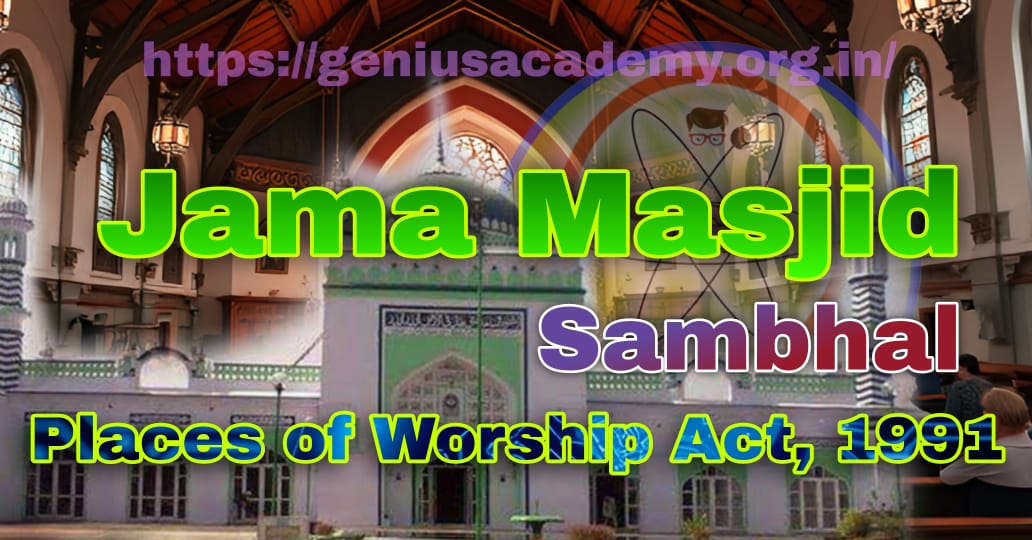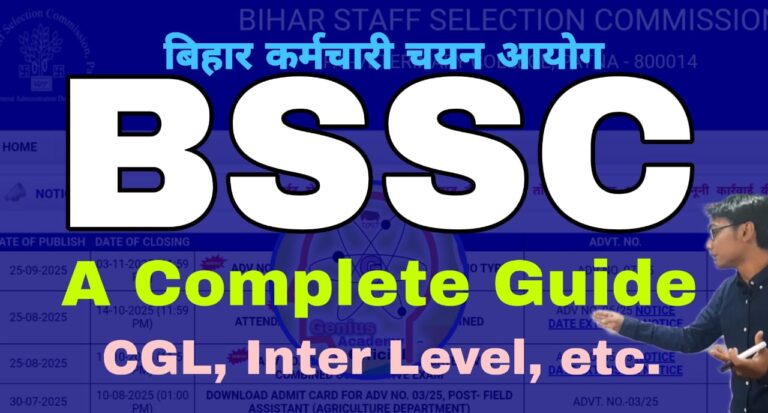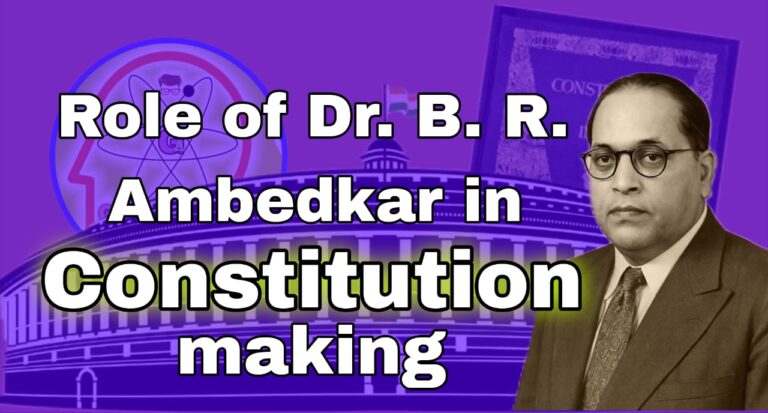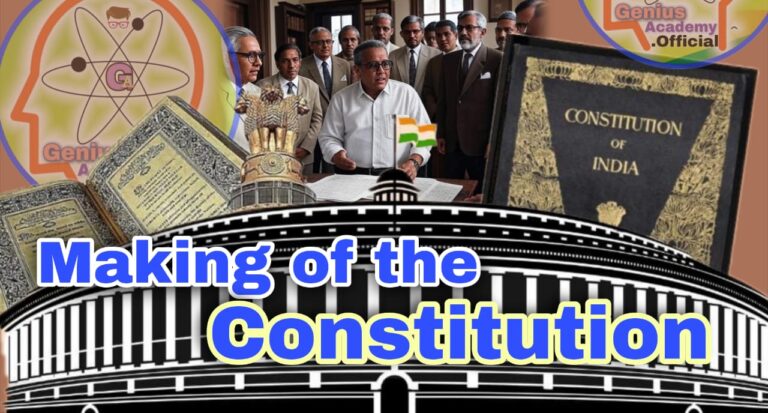The Dispute Over Jama Masjid in Sambhal: Historical, Legal, and Social Dimensions
Introduction
The recent controversy surrounding the Jama Masjid in Sambhal highlights the complexities of balancing constitutional principles, historical narratives, and communal sensitivities. The case involves a petition alleging that the mosque was built on the ruins of an ancient Hari Har Mandir by Mir Hindu Beg, a general of Mughal Emperor Babur. This issue, compounded by historical claims and legal constraints, has sparked protests, legal challenges, and debates about the Places of Worship Act, 1991.
Historical Background of Jama Masjid, Sambhal
Construction and Architecture
- Builder: The Jama Masjid in Sambhal was constructed around 1528 by Mir Hindu Beg, a general under Mughal Emperor Babur.
- Design: The mosque features stone masonry with plaster, akin to the architectural style of the Budaun mosque.
- Historical Claims: Local traditions and some petitions claim that the mosque incorporates remnants of an ancient Vishnu temple. This narrative forms the crux of the current legal dispute.
Relevance of Sambhal in Indian History
- Sambhal was historically a significant administrative and cultural center during the Mughal era.
- The town’s strategic importance and its religious diversity make it a focal point of historical claims and counterclaims.
The Recent Issue
Court-Ordered Survey
- A district court in Sambhal ordered a survey of the Jama Masjid site following a petition claiming the mosque was built on the ruins of a Hindu temple.
- The petitioners, including a local mahant and advocate Hari Shankar Jain, sought to change the religious character of the site.
- The court’s survey order led to protests, culminating in violence and police intervention.
Nature of the Petition
- The petitioners allege that the site’s original identity as a temple was altered during Babur’s reign.
- They argue for the restoration of the site’s supposed original Hindu identity.
Protests and Social Tensions
- The survey triggered widespread protests in Sambhal, with allegations of religious insensitivity.
- Violence and police firing underscored the community’s concerns over such disputes rekindling historical tensions.
Legal Context of the Issue
Protected Monument Status
- The Jama Masjid is listed as a Monument of National Importance by the Archaeological Survey of India (ASI).
- It is protected under the Ancient Monuments Preservation Act, 1904, which mandates the preservation of its architectural and historical integrity.
Ex-Parte Court Order
- The district court’s order was passed ex-parte, meaning the decision was made without hearing all parties involved.
- This raises concerns about procedural fairness and adherence to natural justice.
Role of the Places of Worship Act, 1991
Background and Purpose
The Places of Worship Act, 1991, was enacted to preserve the status quo of places of worship as they existed on August 15, 1947. It aimed to prevent religious disputes and ensure communal harmony.
Main Features
- Freezing Religious Character:— The Act mandates that the religious identity of places of worship remain as they were on the cut-off date (August 15, 1947).
- Prohibition of Conversion:— No place of worship can be converted to a different denomination or religion.
- Termination of Legal Disputes:— All pending disputes regarding the status of places of worship as of the cut-off date were to be terminated.
- Penal Provisions:— Attempts to alter the religious character of a site can result in imprisonment (up to 3 years) and fines.
Exceptions
- Disputes settled before the Act’s commencement are excluded.
- The Babri Masjid-Ram Janmabhoomi case in Ayodhya was explicitly exempted.
- Ancient monuments governed by the Ancient Monuments and Archaeological Sites and Remains Act, 1958, are not covered by this Act.
Challenges to the Places of Worship Act
Judicial Review and Retrospective Cut-Off
- Critics argue that the Act bars judicial review, which is a fundamental constitutional principle.
- The retrospective cut-off date (August 15, 1947) is viewed by some as arbitrary and unfair.
Religious Rights
- The Act has been criticized for potentially abridging the rights of Hindus, Jains, Buddhists, and Sikhs to reclaim historically disputed sites.
- It restricts the assertion of religious claims, which some view as a violation of fundamental rights.
Judicial Interpretations
- In 2022, the Supreme Court clarified that while inquiries into the religious character of a site as of August 15, 1947, may be permitted, altering its religious nature is prohibited.
- This interpretation has allowed district courts to entertain petitions concerning historical claims, despite the Act’s restrictions.
Broader Implications of the Dispute
Secularism and Constitutional Principles
- The issue tests the Indian State’s commitment to secularism, as enshrined in the Constitution.
- Balancing historical grievances with constitutional mandates remains a complex challenge.
Impact on Communal Harmony
- Disputes over religious sites risk exacerbating communal tensions, as seen in the Sambhal protests.
- Ensuring social harmony requires sensitive handling of such cases.
Role of Historical Narratives
- Historical claims, whether factual or mythological, often fuel legal disputes.
- An objective approach to history, devoid of communal biases, is essential for conflict resolution.
Way Forward
Reaffirming Legal Frameworks
- Strengthening adherence to the Places of Worship Act, 1991, is crucial for preventing future disputes.
- Ensuring transparency and fairness in judicial processes, such as avoiding ex-parte orders, can build public trust.
Community Dialogue
- Encouraging interfaith dialogues can help mitigate tensions and foster mutual understanding.
- Collaborative efforts between religious and community leaders can promote reconciliation.
Preservation of Historical Sites
- Protecting the architectural and cultural heritage of sites like the Jama Masjid requires a depoliticized approach.
- Greater involvement of experts from archaeology and history can provide objective insights.
Judicial Oversight
- The judiciary must navigate these disputes carefully, balancing historical claims, religious rights, and constitutional principles.
- Establishing specialized tribunals for religious disputes could expedite resolutions while minimizing social disruptions.
Conclusion
The controversy over the Jama Masjid in Sambhal is emblematic of the challenges India faces in preserving its multicultural and pluralistic ethos. While legal frameworks like the Places of Worship Act aim to maintain the status quo, historical grievances and community sentiments often complicate matters. Resolving such disputes requires a delicate balance of constitutional principles, historical objectivity, and communal harmony. The judiciary’s role in upholding fairness and the State’s commitment to secularism will be pivotal in shaping the future course of such cases.
Daily Mains Practice Questions
UPSC (CSE) Mains Questions on Jama Masjid : Places of Worship Act, 1991
General Studies Paper I (History and Society)
| [Q1.] Examine the historical factors leading to disputes over religious sites in India, using the Jama Masjid in Sambhal as an example. (250 words) |
| [Q2.] Discuss the role of Mughals in shaping India’s architectural and cultural heritage, focusing on instances of religious conversions of sites. (250 words) |
| [Q3.] How do historical narratives influence contemporary communal and societal relations in India? Discuss with examples. (250 words) |
General Studies Paper II (Polity and Governance)
| [Q4.] The Places of Worship Act, 1991, was enacted to maintain communal harmony. Critically evaluate its impact and challenges in implementation. (250 words) |
| [Q5.] Discuss the constitutional principles of secularism and judicial review in the context of disputes over places of worship. (250 words) |
| [Q6.] Examine the role of the judiciary in addressing disputes involving historical and religious sites while maintaining constitutional principles. (250 words) |
General Studies Paper III (Internal Security and Society)
| [Q7.] Analyze how disputes over religious sites, like the Jama Masjid in Sambhal, affect communal harmony and public order in India. Propose measures to address such challenges. (250 words) |
| [Q8.] Discuss the legal and administrative frameworks in India for protecting historical monuments and their implications for disputes over places of worship. (250 words) |
FAQs : Jama Masjid : Places of Worship Act, 1991
1. What is the significance of the Jama Masjid in Sambhal?
Answer:—
- The Jama Masjid in Sambhal is a historical structure built in 1528 by Mir Hindu Beg, a general of Mughal Emperor Babur
- Architecturally, it showcases stone masonry with plaster and is similar to the Budaun mosque.
- It is a protected monument under the Ancient Monuments Preservation Act, 1904, and listed as a Monument of National Importance.
2. What is the Places of Worship Act, 1991?
Answer:—
- This Act was enacted to maintain the status quo of religious places as they were on August 15, 1947.
Key Features:
- Prohibits the conversion of religious places to different denominations..
- Freezes the status of religious sites as they existed on the cut-off date.
- Excludes disputes settled before the Act or the Babri Masjid-Ram Janmabhoomi case.
- Violations can result in imprisonment (up to 3 years) and fines.
3. Why is the Places of Worship Act being challenged?
Answer:—
- Judicial Review: Critics argue that it bars judicial review, violating a basic constitutional principle.
- Retrospective Date: The cut-off date of August 15, 1947, is seen as arbitrary and restrictive.
- Right to Religion: It potentially curtails the right to reclaim religious sites of historical significance.
4. How does the judiciary address such disputes?
Answer:—
- The judiciary balances constitutional principles like secularism, the right to religion, and communal harmony.
- In 2022, the Supreme Court allowed limited inquiries into the religious character of sites as they existed on August 15, 1947, but prohibited altering their status.
5. How do disputes over religious sites affect communal harmony?
Answer:—
- Such disputes rekindle historical grievances, leading to protests, violence, and societal divisions.
- The recent protests in Sambhal following the survey order highlight these challenges.
6. What measures can prevent disputes over religious sites?
Answer:—
- Strengthen Legal Frameworks:— Strict enforcement of the Places of Worship Act and related laws.
- Promote Interfaith Dialogue:— Engage religious leaders and communities in collaborative discussions.
- Objective Historical Research:— Use archaeological evidence to address disputes impartially.
- Judicial Oversight:— Ensure transparency and fairness in legal proceedings.





